Analyzing how retail investors can grasp the latest gameplay on the BNB Chain and BNB valuation analysis.
Author: Biteye core contributor @viee7227
Recently, BNB has experienced a remarkable structural market trend. After reaching an ATH in July, it has again broken the ATH of $865.68 today. With several U.S. listed companies significantly buying BNB as an asset reserve, along with favorable ETF applications, BNB, once viewed as a 'exchange platform token' + 'public chain ecological token', is now evolving towards being an 'institutional reserve asset'.
The current market trend may not just be a temporary speculative heat, but rather a reassessment and repositioning of BNB's value. This article will delve into the 'institutional' path of BNB and the various opportunities for retail investors to participate.
I. Review of BNB's 'Institutional Evolution' Path
In the past two months, three major events have occurred around BNB:
Several U.S. companies have included BNB in their asset reserves: since July, several U.S. listed companies have announced purchases or fundraising for BNB allocation: for instance, CEA Industries plans to raise $500 million (up to $1.2 billion) with the support of Yzi Labs to build the largest BNB reserve; Liminatus Pharma intends to invest up to $500 million in long-term BNB; Windtree Therapeutics has approved up to $700 million for acquiring BNB; Nano Labs plans to invest $1 billion to gradually hold 5% to 10% of the circulating BNB supply, and has already purchased 128,000 BNB off-market. This series of initiatives marks that BNB is being regarded by some institutions as a reserve asset comparable to Bitcoin.
ETF Windfall: In early May, well-known asset management company VanEck officially submitted BNB ETF application documents to the U.S. SEC, including staking and other additional benefits. If approved, BNB is expected to become the focus of the next round of crypto ETF competition, following Bitcoin and Ethereum.
BNB price breaks historical high: Supported by the aforementioned favorable factors, BNB continues to strengthen and climbed to an all-time high of $865.68 on August 14. The following figure shows that since mid-July, the weighted funding rate of BNB holdings has continuously risen from negative to positive, repeatedly reaching about 0.015%-0.03%/8 hours between 7/23 and 8/14, rising in tandem with the price; during the pullback phase, it did not turn negative for long, indicating that the bulls dominate, with both spot and leverage jointly pushing prices, showing sufficient upward momentum and relatively healthy structure.
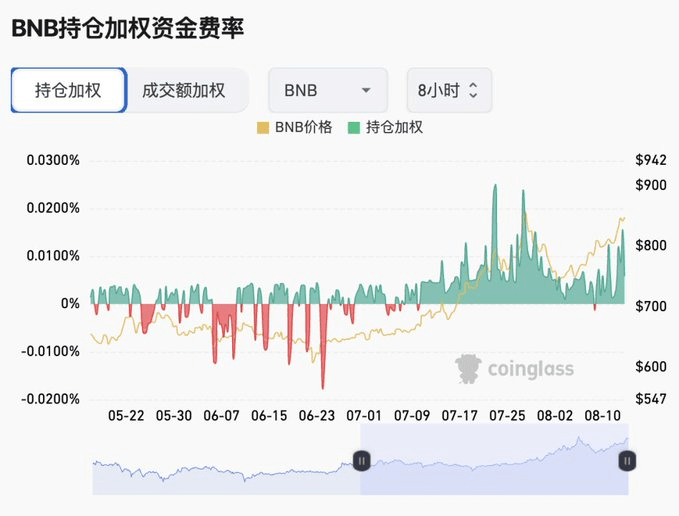
Source: Coinglass
The events above reflect the institutional transformation of BNB, expanding from the past reliance on the internal value support of the Binance ecosystem to a new stage where it is actively allocated by traditional institutions. When 'Wall Street-style' buying pressure surges in, the structural uplift of BNB's value center has the motivation, providing a longer-term and stable source of demand. For retail investors, it is time to reassess the long-term potential of BNB and share in the growth dividends of BNB through various avenues.
II. Retail Investor Opportunity 1: On-Chain Gameplay of BNB Chain
For retail investors, actively participating in the BNB ecosystem on-chain is an essential way to gain value increment, which can be achieved through various methods like DeFi, RWA, and Meme.
DeFi: The leading DEX and lending protocols on the BNB Chain have achieved a top industry TVL. For example, the leading decentralized exchange PancakeSwap (V3) has a TVL of about $2 billion, providing liquidity pool yields for various currency pairs; the established lending protocol Venus supports lending for mainstream assets like BNB; Lista DAO's TVL has also reached $1 billion. Retail investors can choose suitable DeFi strategies based on their risk preferences (as shown in the image below).
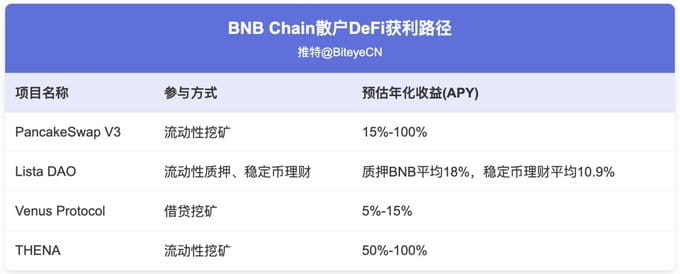
RWA: The BNB Chain is rapidly becoming an emerging platform for RWA on-chain. Ondo Finance announced in July that it would introduce its tokenized products for over 100 U.S. stocks and ETFs to the BNB Chain, allowing global users to trade part of U.S. stock assets 24/7. Meanwhile, the xStocks program launched by Kraken and asset management company Backed will also be deployed on the BNB Chain, supporting the trading of over 60 U.S. stocks and ETFs. In terms of stablecoins, the Trump family company WLFI chose to launch its compliant stablecoin USD1 on the BNB Chain, which has now integrated into the BNB Chain DeFi system and opened a USD1 liquidity pool. Retail investors can more conveniently invest in U.S. stocks, U.S. bonds, etc., on the BNB Chain, achieving diversified asset allocation.
Meme: Earlier this year, several phenomenon-level Meme tokens were born on the BNB Chain, with unprecedented market enthusiasm. If you are interested in trading Meme coins, you can scan the chain on Four.meme, the first Meme fair issuance platform on the BNB Chain, and pay attention to newly deployed tokens. Of course, remember that Meme markets change rapidly; currently, enthusiasm has significantly decreased, so it is best to wait for enthusiasm to rise again before investing. From the market opportunity perspective, Meme enthusiasm can bring considerable trading volume and new users to the BNB Chain, further boosting the demand for BNB, which benefits BNB holders indirectly.
Overall, the BNB Chain ecosystem is in an upward phase of inflow of traffic and value. For retail investors, this also means that on-chain opportunities are gradually exploding, allowing one to earn steadily in blue-chip DeFi projects, try RWA gameplay, or even discover dark horse Memes. As the core value carrier of BNB Chain, the prosperity on-chain will ultimately translate into value support for BNB. Therefore, by deeply participating in the BNB Chain ecosystem, one is also growing together with BNB.
III. Retail Investor Opportunity 2: Stock-BNB Resonance, 'BNB Concept Stock' Stealth Strategy
In simple terms, when a listed company announces a significant purchase of BNB or incorporates BNB into its financial strategy, the stock trends of these companies start to become highly correlated with BNB. When BNB surges, they often experience synchronous or exceed proportionate increases; conversely, the same applies. Therefore, if one is confident in the fundamentals of BNB, they may consider laying out related concept stocks before the market starts. For example, MicroStrategy continuously buys Bitcoin, and retail investors buying MicroStrategy's stock effectively bet on Bitcoin's trend, sometimes even surpassing Bitcoin's increase during the same period. Now, with the rise of institutional accumulation of BNB, it is expected to replicate this kind of stock-BNB resonance effect.
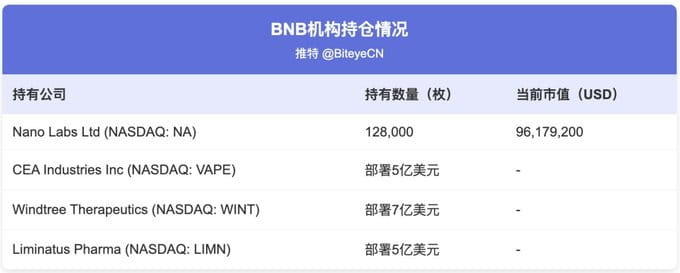
As mentioned earlier, several companies plan to include BNB in their asset reserves (as shown in the image), and their stocks are highly correlated with BNB. So how should retail investors operate and control risks?
Grasping the rhythm of information: Closely monitor the announcement time points of the above companies regarding BNB. Often, the stock price has already surged at the moment the news is released, increasing the risk if one chases it afterward. For example, pay attention to key nodes such as SEC filings, fundraising, and the completion of purchases. Layout at low levels before the news, and choose to take profits in batches when the news materializes.
Focus on BNB price correlation: These stocks have become highly correlated with BNB prices. For example, when BNB broke $800 at the end of July, CEA, Windtree, etc., rose in the same day; conversely, the stocks will also show some pullback. Therefore, BNB market trends can be used as leading indicators; if one judges that BNB will start a new wave of growth, they can correspondingly increase holdings of related stocks and wait for resonance. However, it is essential to note that if BNB experiences significant fluctuations, stocks may exhibit even more severe volatility.
Pay attention to the relationship between concept stocks and Binance: Some stocks are more favored in the market due to the involvement of Binance or CZ. Therefore, one can pay attention to whether there are any further cooperation supports from the official side for these companies, such as whether they provide custody, strategic guidance, etc. These signals will enhance the market's trust in concept stocks holding BNB, thereby boosting their valuation.
It is worth noting that these opportunities carry dual risks, being influenced both by the volatility of the crypto market and by the factors of the stock market itself (such as dilution from financing, etc.). It is recommended to try a small amount, strictly control positions, and keep track of fundamentals in a timely manner.
IV. Retail Investor Opportunity 3: Exchange Gameplay
In recent years, Binance has launched various activities such as Launchpad, Launchpool, and Megadrop, most of which are related to BNB. In fact, utilizing the exchange's gameplay is equivalent to transforming BNB from a purely investment asset into a tool for obtaining diversified returns, allowing one to enjoy both the appreciation of BNB itself and additional earnings.
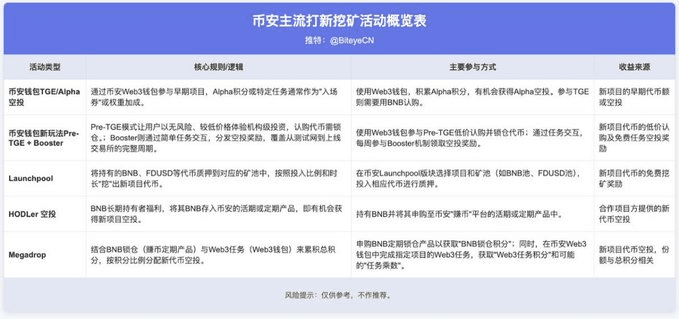
The table below summarizes several mainstream Binance new mining activities, helping everyone choose the suitable way to make money based on their own situation.
You can choose a suitable strategy based on your own capital size and time investment:
Conservative Holding: If capital is abundant but one does not wish to spend too much effort, the 'BNB Holding Party' strategy can be adopted. This means holding a certain amount of BNB long-term and actively participating in Launchpool and periodic HODLer airdrop activities. This strategy emphasizes generating coins from coins, with returns coming from both the appreciation of BNB and new coin airdrops.
Active Participation: If capital is limited but time is abundant and hands-on skills are strong, one can try the 'Alpha Points Party' route, aiming to reach the point thresholds for airdrops/TGE, Pre-TGE, and Booster. After completing tasks, exit promptly to lock in profits. It is important to emphasize that this strategy must calculate costs to avoid losses due to high transaction fees and slippage.
In addition to the main activities mentioned above, Binance also offers a series of rights for BNB holders, such as VIP levels, fee discounts, voting for new listings, Binance Pay cashback, etc. For example, in Binance spot and futures trading, using BNB to offset fees can enjoy discounts. Additionally, BNB holders can participate in some exclusive financial products from Binance Earn, achieving a combination of various rights.
V. Retail Investor Opportunity 4: Hold BNB, Deflation Bonus, and Token Economic Model
Regardless of the gameplay participated in, the vast majority of paths ultimately revolve around holding BNB. The reason why holding BNB is favored by many is primarily due to the deflationary token economic model of BNB, which is the only deflationary token among the top market cap tokens. As of July 2025, about 60 million BNB have been destroyed (accounting for about 31% of the initial supply), and the circulating supply has decreased from 200 million to about 139 million tokens. It is expected that in the coming years, BNB will reach a constant supply target of 100 million tokens.
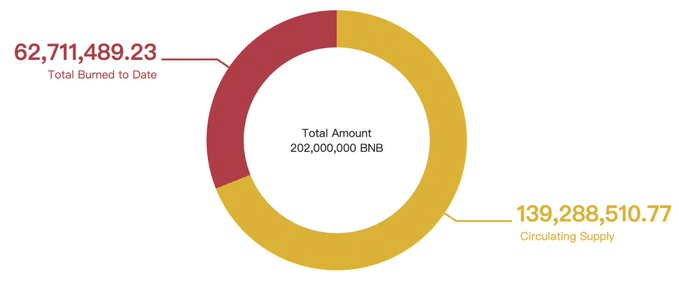
Source: bnbburn.info, Binance Research Institute
Automatic destruction mechanism: The earliest destruction method for BNB was based on the trading volume of BNB on the Binance trading platform. Starting from the fourth quarter of 2021, a new automatic destruction algorithm was introduced, dynamically adjusting according to BNB prices and the number of blocks produced on the BNB Chain. For instance, in the recently completed 32nd quarterly destruction of BNB, a total of 1,595,599.78 BNB were destroyed, valued at approximately $1.024 billion at the time of execution.
The following figure shows the formula for the automatic destruction mechanism, where B represents the amount of BNB to be destroyed this quarter, N represents the total number of blocks produced in the BNB Chain during this quarter (the number is determined by the fixed block time), P represents the average price of BNB, and K is a constant (currently set at 250 after the hard fork upgrade). From the formula, it can be seen that when the price is higher, the amount destroyed is less, and vice versa. The essence of this mechanism is to increase the intensity of deflation during market downturns by reducing circulation to maintain the value peg of BNB; while in a hot market, it automatically reduces the destruction intensity to avoid excessive tightening of supply.

Real-time destruction mechanism: In addition to quarterly concentrated destruction, the BNB Chain introduced the BEP-95 protocol in 2021 to achieve real-time destruction on-chain. A fixed proportion of the gas fees paid for each BNB Chain transaction will be directly burned. The more prosperous BNB becomes, the more BNB will be destroyed. In the long run, the growth of on-chain activity will also drive an increase in trading volume, triggering more real-time destruction.
For retail investors, the deflation of BNB means increased scarcity. Assuming stable or growing demand, a decrease in supply will raise the intrinsic value of each token. This is similar to a listed company continuously repurchasing stocks, increasing earnings per share and net assets, thus benefiting stock prices. It is worth noting that BNB's commitment is to around 100 million tokens, which will not decrease infinitely to avoid affecting network operational security. Therefore, when approaching 100 million, it is essential to monitor whether policy adjustments are made, such as converting to maintain a constant inflation rate. However, at least in the coming years, the deflation trend is clear.
VI. BNB Value Reassessment and Future Outlook
With the entry of institutions, traditional financial institutions are also changing their valuation of BNB. For example, Standard Chartered Bank pointed out in its report in May this year that it expects the price of BNB to double by the end of 2025, reaching about $1275, and is expected to further rise to around $2775 by the end of 2028.
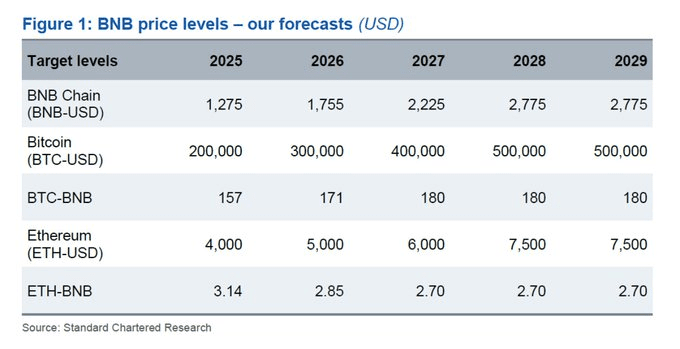
Source: Standard Chartered Bank (for reference only)
In addition, the development of BNB in the payment sector will also provide additional support for its value, further driving the market's upward revision of its valuation model. Binance's payment application, Binance Pay, has already been promoted globally, making BNB one of the important settlement currencies. Data shows that Binance Pay has processed 300 million transactions, with a total transaction volume of $230 billion, a significant portion of which uses BNB for transactions. For instance, in the French Riviera region, Binance has collaborated with fintech company Lyzi to support cryptocurrency payments for over 80 local merchants, including various currencies like BNB. If this trend continues, BNB's demand will come not only from investment and trading but also from genuine commercial circulation.
In summary, as of mid-2025, BNB is in an upward channel of value reassessment. Institutional accumulation has given it the narrative of 'digital gold reserve', ecological prosperity has given it the narrative of 'leading public chain', and payment expansion has given it the narrative of 'utility currency'. The accumulation of multiple narratives provides BNB with the potential for further market capitalization growth. At the same time, it is essential to remain rational; the long-term value of BNB ultimately depends on whether the ecosystem can continue to build and maintain innovation and stable operations in an ever-changing market.
VII. Conclusion
From the initial platform token to a popular public chain token, and now becoming a crypto asset allocated by traditional institutional investors, the transformation of BNB also reflects the maturation of the crypto industry. In the wave of institutional accumulation, retail investors can share in the value growth of BNB through deep on-chain participation, laying out related concept stocks, participating in exchange activities, and holding BNB. As the slogan goes, 'Build and Build', the value of BNB will be shaped by everyone collectively. Looking ahead, under the joint efforts of institutions and retail investors, can BNB open a new round of innovative golden age? Let’s wait and see.

